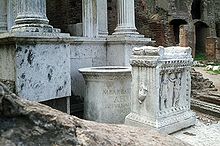 The aedicula and marble altar of the Lacus Iuturnae. | |
| Location | Regione VIII Forum Romanum |
|---|---|
| Coordinates | 41°53′31″N12°29′9″E / 41.89194°N 12.48583°E |
| Type | fountain |
The Lacus Iuturnae, or Lacus Juturnae or Spring of Juturna , is the name of a formal pool built by the Romans near a spring or well in the Roman Forum. [1] [2] [3] The pool was part of a shrine dedicated to the water nymph Juturna, and the name Lacus Iuturnae is also used for the spring and the shrine, both next to the pool. [4] [5]
Contents
The site was initially excavated by Giacomo Boni in the early twentieth century. Excavations from the 1980s onwards were supervised by Eva Margareta Steinby. [2]



